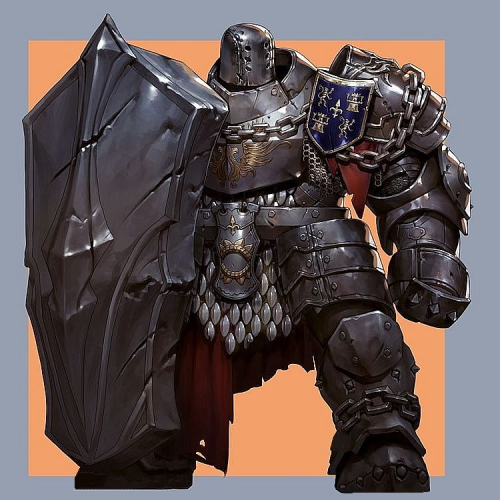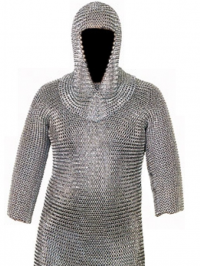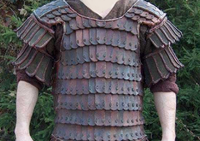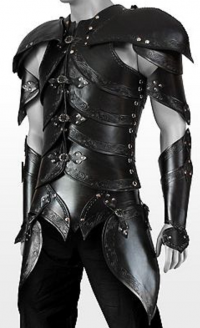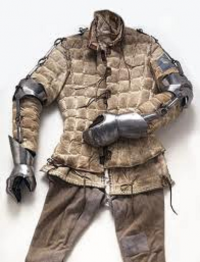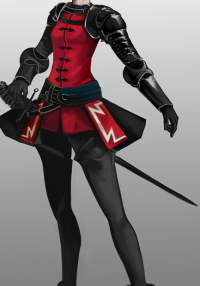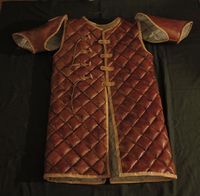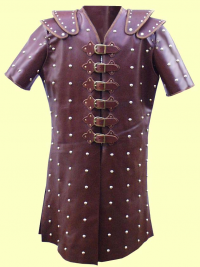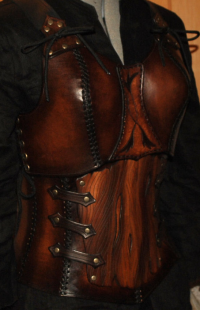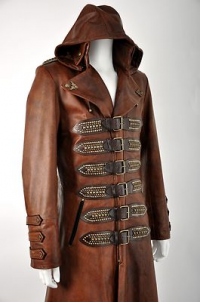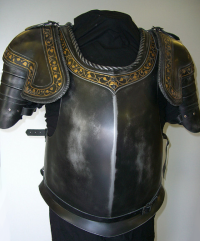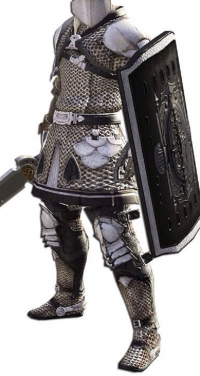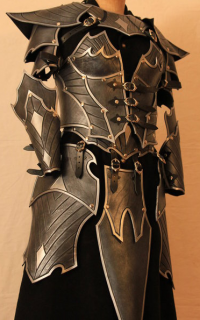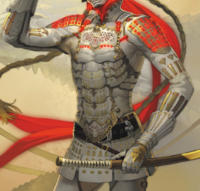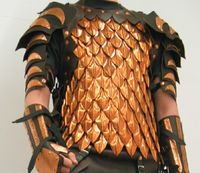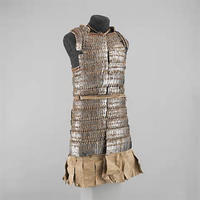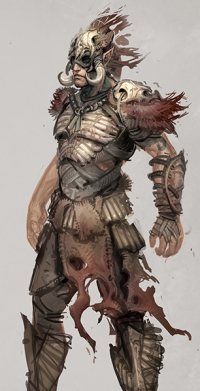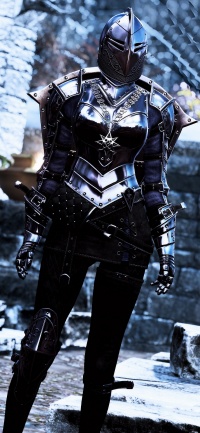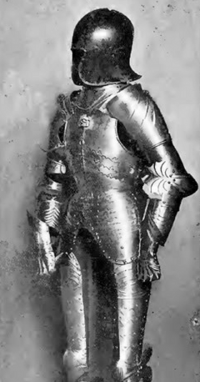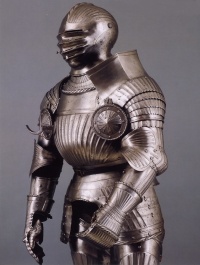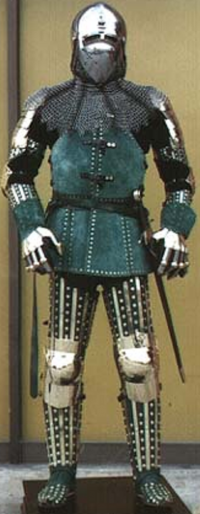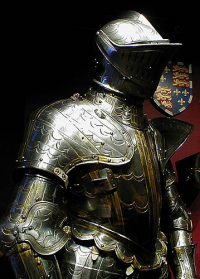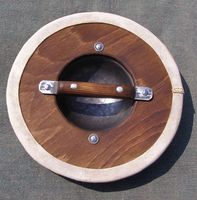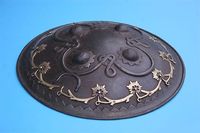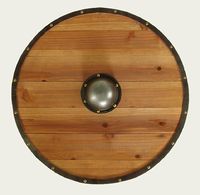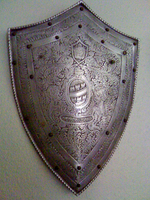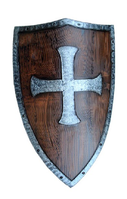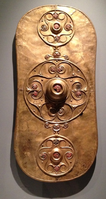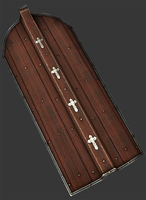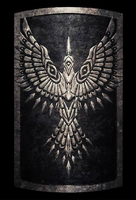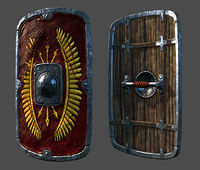Armor and Shields
Armor and Shield Proficiency
All armors are defined as Non-Armors, Light Armor, Medium Armor and Heavy Armor.
Shields are all described together as Shields, or if you want to check out just the fancy ones, look at the Exotic Shields.
- Non-armors take up the armor slot on the body, may be worn without proficiency without penalty, but they may not have magical armor properties.
- Light armors take up the armor slot on the body, require proficiency to wear without penalty, and may have magical armor properties.
- Medium armors take up the armor slot on the body, require proficiency to wear without penalty, may have magical armor properties, and reduce all movement rates greater than 20 feet per round by 5 feet. Movement rates of 20 feet per round or less are not reduced by medium armor.
- Heavy armors take up the armor slot on the body, may not be worn without proficiency without penalty, may have magical armor properties, reduce all movement rates greater than 20 feet per round by 10 feet and reduce all movement rates of 20 feet per round or less by 5 feet per round (to a minimum of 5 feet per round).
Most characters gain proficiency with armor or shields as a result of their chosen character class. However, characters may also take one or more of the following feats to gain proficiency with armor and shields which are not normally wearable by their character class:
The heaviest shields require their own feats to wear them without penalty. These are:
Note that a few character classes have the ability to wear a Tower Shield as part of the armor and weapon proficiencies offered by the class. These classes obviously do not need to take the Shield Use: Tower Shield feat, since their class grants it for free.
Magic Armor and Shields
Rules for the creation, cost and effects of magical armor and shields can be found on the following pages:
- Crafting Magic Armor
- Magic Shields
- Dweomermetals
- Armor Magic Properties
- Shield Magic Properties
- Reforging
Shield Basic Rules
Shields are items which must be wielded in order to be used. This means that shields must be equipped into the wielded slot, almost always into the off-hand. A shield or any other item that is in any form of storage upon the body of a character (in a sheathe, a pack, strapped to a forearm, balanced on one shoulder, concealed upon your person, etc) provides no benefit to the owner of any sort until it is drawn and wielded. The only way to use the Shield Bash Combat Maneuver is to have an equipped light, heavy or war shield.
Only one item may be used in each hand's wielded slot. Given that weapons, shields, rods, staffs, wands, musical instruments, potions, and alchemical items all use one (or both) of the wielded slots, choosing what item a character is wielding in their hands is an important call.
In many cases, it is possible for a character to have more than one item prepared for use in a wielded slot. One of the most common examples of this is a buckler shield, which is strapped to the arm, and the same hand can be holding a weapon or other item. However, even though two items are ready for use for that hand, only one of them may be wielded each round. If you have a buckler on your off-hand and are also using a dagger in that same hand, you can only gain the benefit from one of those items each round. If you use the dagger during the round, the AC bonus from the buckler (and any of its magic enchantments, properties, or dweomermetal effects) are not applied to your character during that round. Similarly, if you want to retain the bonuses from the buckler, you may not use the dagger, nor gain any benefit from its magical enchantments or qualities.
Switching from one item to another in the same hand slot is a free action that can only be performed during your turn. Similarly, if you have a single item which uses two hands, you can release one hand from that item to do something else with that hand as a free action. Re-gripping a two-handed item is another free action that can only be performed during your turn. You can release your grip, use a different item, and re-grip, in the same round.
Drawing a shield or any other item from storage upon a characters body requires either a move action, or it may be performed as part of a move action. Putting a shield back into storage on a character's body is also a move action, or part of a move action. If a character takes a double move in a single round, they may switch shields (or other hand-slot items) during each those two move actions. Running (taking the Run maneuver) does NOT allow this.
Dropping a held item into a square you occupy is a free action that can be performed at any time, including outside of your turn. You may drop an item and ready another with a free action and a move action (or as part of a move action) in the same round. If you move away from the square in which you dropped an item, you may wish to retrieve the dropped item from where you dropped it later.
If you are holding an item in a shield hand, you can transfer that item to your other hand (assuming it is not already holding something else) as a free action. You may also move something into your shield hand as a free action (assuming it is empty, save for the shield) rather than dropping it, if you are wearing a shield that allows the hand to be used (light shields and bucklers).
Armor Basic Rules
Armor is a whole-body item which fills the armor slot. It takes a very long time to properly put on or take off Armor, to the point that it's almost impossible to do during a combat. As a result, many of the more heavily-plated characters out there should look keenly at the Endurance (Feat), because trying to sleep in Armor is not much fun, and if you do so, you are going to wake up with the Fatigued condition. Asking your healers and buffers to expend resources to fix you up every morning gets old quickly, let us assure you.
If you stubbornly try to put on armor quickly, see the donning and doffing rules, laid out below. You're probably going to miss most of the fight, though.
Once you have a suit of Armor on, it is surprisingly low maintenance. You wear it, and it grants its benefits and difficulties for as long as you wear it. Its pretty simple, actually.
Armor and Shield Non-Proficiency
In order to wear armor or a shield without suffering a non-proficiency penalty, the wearer must either be permitted to wear that armor or shield by their chosen character class or have the appropriate proficiency feat for the armor type in question (e.g. Shield Proficiency, Light Armor Proficiency, Medium Armor Proficiency or Heavy Armor Proficiency).
A character who wears armor and/or uses a shield with which they are not proficient takes a penalty to to-hit rolls and Str- and Dex-based ability and skill checks equal to either -4 , or the armor's (and/or shield's) armor check penalty, whichever is greater. The penalty for non-proficiency with armor stacks with the penalty for non-proficient shields or non-proficient weapons.
Armor Bonus to AC
The entire POINT of wearing armor is that it grants a native, non-magical, Armor Bonus to the Armor Class of the user. Even better, this armor bonus is always on, it cannot be negated in any way, and if you are willing to wear the heavier armors and shields, it can be extremely large. War Plate and a Tower Shield, without any other bonuses at all, can get a typical level 1 character to an AC of 24, which is...pretty incredibly good. As an added benefit, Armor is not worn in a 'normal' magic item slot, which means that if you wear armor, you get the benefits of an 'extra' magic item, and it is a really nice item, as Armor Properties can be applied to Armor (and only armor) which can be really, really nice. And on top of that, Armor can be made out of Dweomermetals, which adds another entire stack of amazing effects. Armor is very, very nice indeed. Of course, all these great benefits come with some pretty heavy downsides, so there are tradeoffs to all these sorts of things.
Dex Penalty to AC
And, speaking of downsides, here is a big one. Armor and the biggest Shields are heavy, bulky, and hard to wear. This causes lots of big problems for wearing super-heavy armor and shield, and the first one is, many suits of armor are so heavy and difficult to wear that they penalize the amount of AC you can get from your Dexterity. If you are wearing a suit of armor and carrying a shield that both have a penalty to your Dex modifier to AC, then those bonuses stack (add together). However, your total Dex modifier to AC can never be decreased below zero by armor or shields. Even so, if you want to be extremely "dodgy", you need to carefully choose armor that is light and easy to move in, or you need to check for magic items (Warrior Harness) that can make this problem less of a problem. War Plate and a Tower Shield is incredible, but with a total penalty to your Dex modifier to AC of five points, you're not going to be dodging nearly as well in that massive tank-like outfit.
Armor Check Penalty
Most armors, as well as any shield, hurt a character's ability to use Dexterity and Strength based Skills. The armor check penalty listed for each suit of Armor applies to all Dexterity and Strength based skill checks. A character's Encumbrance may also incur an armor check penalty. If a character is wearing armor and using a shield, the armor check penalties of both are added together before being applied to Dexterity and Strength based skills. (Ouch, but, check out the Warrior Harness, linked above. It's kinda choice if you like being your own battleship).
Armor check penalties apply even when a character is proficient with the armor or shield they are wearing. However, armor check penalties do not apply to any skill with which the character has a Natural Talent, even if the skill in question makes use of the character's STR or DEX modifier. Now, a quick check of the Skills table at the page linked above will show that there are a LOT of nice skills that are made more difficult by wearing a portable castle. Choose carefully what skills you want to be your natural talents, or invest in items that make armor less burdensome.
Arcane Spell Failure Chance
Armor interferes with the gestures and even worse, the inherent aura, of arcane spells. Divine spells are granted a boon, that they are able to bypass this interference, which is why you see so many clerics in chainmail. Arcane spellcasters face the possibility of arcane spell failure if they are wearing armor. Bards, luckily enough, can tie their aura to their identity as performers, and can thus wear light armor and use shields without incurring any arcane spell failure chance for their bard spells.
Arcane spell failure chance does not apply to arcane spell effects created by the use of a magic rod, a magic scroll, or from a potion.
Casting an Arcane Spell in Armor: A character who casts an arcane spell while wearing armor must usually make an arcane spell failure check. The number in the Arcane Spell Failure Chance column on Table: Armor and Shields is the percentage chance that the spell fails and is ruined.
Shields: If a character is wearing armor and using a shield, add the two numbers together to get a single arcane spell failure chance.
Movement Penalties
Medium and heavier armor is heavy, stiff, and slows down your movements. All such armors incur a penalty to the movement rate of sized Medium adventurers. Luckily, size Small adventurers, due to their more petite size, are able to suffer a smaller penalty, if they suffer one at all. Of course, being sized Small such adventurers are frequently less swift on their feet than their larger brethren, so this tends to balance out.
Durability
Armor and shields are designed to take a severe beating. After all, that is what it's for, right? No amount of normal damaging attacks, of any sort, can ever harm or disable armor in any way. However, if Armor or Shield is targeted by a Sunder maneuver (darn rust monsters....), then...it still keeps working!
Unlike almost every other thing that any adventurer possesses, Armor and Shields have a Durability score. Armor and Shields are not broken until they take a number of Sunders that EQUALS or EXCEEDS their Durability score. What this means, is that a suit of Armor, or a Shield, almost always has to be Sundered (or otherwise take points of Siege Damage) more than once before it actually inflicts the Broken condition on its wearer. Some really heavy suits of armor can take five sunders, or even more, before they finally give up the ghost and become officially Broken. Nothing else, short of buildings or vehicles, are that tough.
Weight
Armor and Shields are heavy. Indeed, at the beginning of most games, the sheer, grinding mass of Armor means that many players can't wear it, just because it's so heavy they couldn't move with it on! There's a good reason so many Fighters and Paladins have big Strength scores. They need to be that strong just to stand up in that tank-like carapace.
Cost
Armor and Shields are expensive, especially when you're building a character for the start of their career. The Medium Armor, a Breastplate, is pretty sweet stuff...until you realize it costs a whopping 200 gold! Sure, you can likely wear that....but you probably won't have much in the way of other gear. We won't even talk about the price of a suit of War Plate!
Special Stuff
Lots of Armor and Shields have 'other things' that they do. Padded Armor is cozy and warm, if your campaign is set on a glacier. Wooden armor is breezy and cool, if your game starts off in a searing jungle. The Armored Coat can be put on and off almost immediately, if your game is set in the Imperial Palace, and stomping around in plate mail is going to offend all the wrong sort of people. Be sure to check with your GM about what sort of game you're going to be involved in. The Environmental Effects rules have some real teeth, and wearing padded armor in a jungle is going to get you killed...quick.
A special mention must be made of Gauntlets. All sets of Medium and Heavy armor are considered to have a pair of these weapons included as part of them. They are worn over the Gloves slot, and do not interfere with that item (if you have it). Gauntlets do not interfere with a wielded item in that same hand, and can be used instead of a wielded weapon, rod, wand, etc. You just keep holding the item and declare you are Wielding the gauntlet instead of the weapon or other things you're holding, and then give things a knuckle-dusting with your steel over-gloves. The great thing about Gauntlets is that they are Attached, making them tough to take away (like all things about Armor), and they are close weapons, meaning that if you get swallowed by that pesky T-Rex, you have something you can use to punch your way out with. And that is always going to be a great story. Gauntlets are a great reason to look hard at the Ring of the Weaponeer, just to make that 'gut punching' trick a lot easier.
Donning Armor and Shields
Donning a suit of armor properly takes one minute of time per weight class of the armor, and assumes you have a person helping. Thus, light armor can be donned in one minute, medium armor in two minutes, and heavy armor in three minutes. War Plate requires four minutes to don. Donning armor without a helper requires twice as much time.
You can also hastily don armor in order to quickly make yourself ready for a surprise encounter in the middle of the night. When laying down for the night in hostile territory, armor-wearing adventurers usually arrange their armor in a carefully stacked-up mass, so they can do the 'fireman' trick of just jumping right into it. By arranging the armor in this fashion, the wearer can don it without assistance, and needs one full-round action per weight class of the armor (except for War Plate). Thus, light armor requires a full round, medium armor requires two full rounds, and heavy armor requires three full rounds. War Plate requires four full rounds to don hastily.
Hastily donned armor inflicts a penalty of -1 to the wearer's AC and the Armor Check Penalty is increased by 1. These penalties persist until the wearer can take the time to adjust and strap on the armor properly (requiring minutes per weight class).
If you have assistance while hastily donning armor, your helper can expend a full round action to reduce the total time required for you to hastily don the armor by 1 round. You can have up to two assistants helping you at one time (meaning, with two assistants, you can hastily don heavy armor in one round).
You and any assistants are all assumed to be taking full-round actions when hastily donning armor.
Most shields require only a move action to equip. War shields, however, require a full round action to equip. You do not require assistance when equipping a shield, but having assistance also does not reduce the time required to equip the shield. You cannot hastily don a shield.
Armor Don With Assistance Don Without Assistance Hastily Don1 Light Armor 1 minute 2 minutes 1 full round action Medium Armor 2 minutes 4 minutes 2 full round actions Heavy Armor 3 minutes 6 minutes 3 full round actions War Plate 4 minutes 8 minutes 4 full round actions Shield Done With Assistance Don Without Assistance Hastily Don1 Buckler - 1 move action - Light Shield - 1 move action - Heavy Shield - 1 move action - War Shield - 1 full round action - Tower Shield - 1 full round action -
- 1 — Inflicts a -1 penalty to the wearer's AC, and increases the armor check penalty by 1.
Sunders Against Armor
- Armor is more difficult to Sunder than most worn or wielded objects, since its primary purpose is to protect the wearer. Armor has a durability score akin to unattended objects, meaning it has a number of points of Siege Points equal to its Durability score. As a result, it often requires more than one successful Sunder attempt to inflict the Broken condition upon the armor, and it is possible for extremely durable armors to even withstand hits from some smaller siege weapons.
- Light armor has a durability of 2 (requires 2 points of Siege damage to inflict Broken)
- Medium armor has a durability of 3 (requires 3 points of Siege Damage to inflict Broken)
- Heavy armor has a durability of 4 (requires 4 points of Siege Damage to inflict Broken)
- The durability of armor is increased by 1 if the armor is made entirely of metal.
Sunders Against Shields
Shields, like armor, are designed to protect the wearer, and are therefore more difficult to Sunder. Shields have a durability akin to unattended objects, requiring more than one successful Sunder attempt to inflict the Broken condition upon the shield. In addition, if an enemy attempts to sunder any of your worn or wielded items, and you are proficiently wielding a shield, you may ALWAYS elect to have that sunder check apply to your shield instead, as long as your shield does not already have the Broken condition.
- Bucklers have a durability of 1 (requires only 1 point of Siege Damage to inflict Broken)
- Light Shields have a durability of 2 (requires 2 points of Siege Damage to inflict Broken)
- Heavy Shields have a durability of 3 (requires 3 points of Siege Damage to inflict Broken)
- War Shields have a durability of 4 (requires 4 points of Siege Damage to inflict Broken)
- Tower Shields have a durability of 5 (requires 5 points of Siege Damage to inflict Broken)
- The durability of shields is increased by 1 if the shield is made of steel
In addition, some dweomermetals, and some magic properties can alter the durability of a shield.
Magic Armor and Shields
The rules for creating magic armor and shields can be found on the following pages:
Light Armor
Chain Shirt |
Light Armor proficiency required | edit | |||||||
|---|---|---|---|---|---|---|---|---|---|
| Cost | Armor Bonus to AC |
Dex Penalty to AC |
Armor Check Penalty |
Arcane Spell Failure |
Move Penalty | Durability | Wt | ||
| Size Medium | Size Small | ||||||||
| 30 gp | 4 | -1 | -2 | 20% | 0 | 0 | 3 | 25 lbs. | |
| Special: | |||||||||
| A chain shirt is more accurately described as a chainmail breastplate. It consists of a shirt of padded armor over which is a multiply-linked chainmail shirt which covers the entire torso. Chainmail is made of thousands of interwoven rings of iron, brass, or other readily-worked, high-strength, inexpensive metal. The main cost of chainmail is in the labor used to put it together. A chain shirt is remarkably heavy for its size, but the strength and flexibility give it a very good level of protection for a 'light' armor. | |||||||||
Hide Shirt |
Light Armor proficiency required | edit | |||||||
|---|---|---|---|---|---|---|---|---|---|
| Cost | Armor Bonus to AC |
Dex Penalty to AC |
Armor Check Penalty |
Arcane Spell Failure |
Move Penalty | Durability | Wt | ||
| Size Medium | Size Small | ||||||||
| 20 gp | 3 | -1 | -1 | 15% | 0 | 0 | 2 | 18 lbs. | |
| Special: | |||||||||
| A hide shirt is more accurately called a leather breastplate. It consists of two or more layers of thick linseed-treated top-grain leather laminated with glue and lacquer into a segmented shell to cover the torso. It is lightweight and surprisingly protective, but quite rigid, so it is a bit restrictive. Due to its thick leather construction and good body coverage, it adds 3 points of protection against cold weather environmental effects, which stacks with cold weather clothing and other sources of environmental DR. This type of armor may be constructed from scavenged materials at no cost, but doing so requires a full day. | |||||||||
Leather Armor |
Light Armor proficiency required | edit | |||||||
|---|---|---|---|---|---|---|---|---|---|
| Cost | Armor Bonus to AC |
Dex Penalty to AC |
Armor Check Penalty |
Arcane Spell Failure |
Move Penalty | Durability | Wt | ||
| Size Medium | Size Small | ||||||||
| 10 gp | 2 | 0 | 0 | 10% | 0 | 0 | 2 | 15 lbs. | |
| Special: | |||||||||
| Leather armor consists of a suit of heavy cotton or linen which has been covered and reinforced with thick top-grain leather pieces treated with linseed oil, for hardness and supple durability. Heavy leather gloves and boots protect the hands and feet, while a sturdy boiled-leather cap protects the head. This type of armor may be constructed from scavenged materials at no cost, but doing so requires a full day. | |||||||||
Padded Armor |
Light Armor proficiency required | edit | |||||||
|---|---|---|---|---|---|---|---|---|---|
| Cost | Armor Bonus to AC |
Dex Penalty to AC |
Armor Check Penalty |
Arcane Spell Failure |
Move Penalty | Durability | Wt | ||
| Size Medium | Size Small | ||||||||
| 5 gp | 1 | 0 | 0 | 5% | 0 | 0 | 2 | 10 lbs. | |
| Special: | |||||||||
| This armor consists of special clothing. It has a thick jacket made out of heavy cotton cloth and lined with leather reinforcements. The pants are of heavy canvas with leather straps and groin protection. A canvas hood over a leather cap protects the head and neck. Heavy leather boots and thick gloves of padded canvas round out the look. Due to its thickly padded construction and good body coverage, it adds 4 points of protection against cold weather environmental effects, which stacks with cold weather clothing and other sources of environmental DR. | |||||||||
Parade Armor |
Light Armor proficiency required | edit | |||||||
|---|---|---|---|---|---|---|---|---|---|
| Cost | Armor Bonus to AC |
Dex Penalty to AC |
Armor Check Penalty |
Arcane Spell Failure |
Move Penalty | Durability | Wt | ||
| Size Medium | Size Small | ||||||||
| 750 gp | 3 | -1 | -1 | 15% | 0 | 0 | 2 | 20 lbs. | |
| Special: No armor penalty to Stealth | |||||||||
| Parade armor is a product of a sophisticated culture that is capable of producing very protective armors, but chooses to make lighter armor that 'looks good.' This is used for functions such as parades, coronation ceremonies, standing guard in palaces, and so on. For adventurers, parade armor is a level of protection similar to studded leather but which has a little style to it. Parade armor may or may not be available in all campaigns. Parade armor is made of heavy cloth, leather reinforcements that may or may not be visible, and light chainmail reinforcements, which may or may not be visible. Due to this fine construction, parade armor may be constructed from any one of the dweomermetals. Parade armor is often used as a uniform by large and established social organizations, such as governments, churches, martial orders, etc. The clever construction of the armor deadens the noise that leather armors usually make, so wearers do not apply the armor check penalty of parade armor to their Stealth checks. | |||||||||
Quilted Cloth |
Light Armor proficiency required | edit | |||||||
|---|---|---|---|---|---|---|---|---|---|
| Cost | Armor Bonus to AC |
Dex Penalty to AC |
Armor Check Penalty |
Arcane Spell Failure |
Move Penalty | Durability | Wt | ||
| Size Medium | Size Small | ||||||||
| 100 gp | 1 | 0 | 0 | 10% | 0 | 0 | 2 | 15 lbs. | |
| Special: DR 3 vs ranged or thrown piercing weapons (only) | |||||||||
| This armor consists of special clothing. The outer layer is quilted in a diamond shape with a nigh-rigid inner layer of stiff leather, with padding both in front of and behind the inner leather. This armor is designed specifically to resist light thrown piercing weapons (e.g. daggers, shuriken (which are treated as piercing), etc.) and all ranged piercing weapons (e.g. arrows, crossbow bolts, etc.), quilted cloth grants DR 3/-. Against all other forms of attack, it gives only its armor class benefits. | |||||||||
Studded Leather |
Light Armor proficiency required | edit | |||||||
|---|---|---|---|---|---|---|---|---|---|
| Cost | Armor Bonus to AC |
Dex Penalty to AC |
Armor Check Penalty |
Arcane Spell Failure |
Move Penalty | Durability | Wt | ||
| Size Medium | Size Small | ||||||||
| 25 gp | 3 | -1 | -1 | 15% | 0 | 0 | 2 | 20 lbs. | |
| Special: | |||||||||
| Studded leather is a leather armor suit which has been reinforced by the addition of five pounds of hammered brass or iron rivets, studs, and bosses. Anywhere the wearer is likely to suffer a strike will have studs added. Studded leather has a very distinctive 'manly polkadots' look to it. The extra weight and rigidity of the studs makes the leather a bit more cumbersome, but studded leather is otherwise quite a good level of protection. | |||||||||
Wooden Armor |
Light Armor proficiency required | edit | |||||||
|---|---|---|---|---|---|---|---|---|---|
| Cost | Armor Bonus to AC |
Dex Penalty to AC |
Armor Check Penalty |
Arcane Spell Failure |
Move Penalty | Durability | Wt | ||
| Size Medium | Size Small | ||||||||
| 20 gp | 3 | -1 | -1 | 15% | 0 | 0 | 2 | 25 lbs. | |
| Special: +2 circumstance bonus to Movement checks when swimming | |||||||||
| Wooden armor is a suit of padded cloth armor which has been reinforced with various carved wooden parts. The wooden parts used are quite sophisticated, usually consisting of laminated sheets of coppiced ironwood (such as buloke, lignum vitae, or grey ironbark) glued to sheets of a very soft wood (such as balsa, soft pine, or linden). The resulting wooden parts are extremely durable but light, and wooden armor is actually buoyant enough to give the wearer a +2 to Movement checks when swimming. Due to the way its rigid parts allow the skin to breathe, it adds 3 points of protection against hot weather environmental effects, which stacks with hot weather clothing and other sources of environmental DR. This type of armor may be constructed from scavenged materials at no cost, but doing so requires a full day. | |||||||||
Medium Armor
Armored Coat |
Medium Armor proficiency required | edit | |||||||
|---|---|---|---|---|---|---|---|---|---|
| Cost | Armor Bonus to AC |
Dex Penalty to AC |
Armor Check Penalty |
Arcane Spell Failure |
Move Penalty | Durability | Wt | ||
| Size Medium | Size Small | ||||||||
| 50 gp | 4 | -2 | -1 | 20% | -5 | 0 | 3 | 20 lbs. | |
| Special: Can be donned or doffed with a move action. | |||||||||
| An armored coat is a type of armor which is usually seen in more sophisticated, even civilized, settings. An armored coat is a massive leather coat, reaching to the ankles, with panels of light whalebone and heavy layers of linseed-treated top-grain leather in discrete spots for additional protection. Because the coat is not strapped to the body and merely rides on the shoulders it encumbers as medium armor, slowing your movement. But the huge advantage is the ease with which you can slip it on and off. Getting fully armored as a move action is a major advantage! An armored coat can be worn effortlessly over normal clothes, but will not fit over any other sort of armor, so don't try stacking it with other armors. Due to its thick leather construction and good body coverage, it adds 3 points of protection against cold weather environmental effects, which stacks with cold weather clothing and other sources of environmental DR. Note: Mechanically, this item is an 'Armor slot' item, meaning it will stack with 'body' and 'chest' items but not other armor items. This type of armor may be constructed from scavenged materials at no cost, but doing so requires a full day. | |||||||||
Breastplate |
Medium Armor proficiency required | edit | |||||||
|---|---|---|---|---|---|---|---|---|---|
| Cost | Armor Bonus to AC |
Dex Penalty to AC |
Armor Check Penalty |
Arcane Spell Failure |
Move Penalty | Durability | Wt | ||
| Size Medium | Size Small | ||||||||
| 200 gp | 6 | -2 | -3 | 25% | -5 | 0 | 4 | 30 lbs. | |
| Special: | |||||||||
| A breastplate is a vest and pants of padded cloth armor over which there is a solid, sculpted sheet of good-quality steel that covers the chest, belly, and groin in the front, the sides below the armpits, and the back down to the lower back. A breastplate also includes articulated lames for the shoulders and scutes for the buttocks. It leaves the arms, hands, feet, and head uncovered. It offers an amazing amount of protection for the body, and the weight and encumbrance reflect this fact. Due to its metal construction which leaves the limbs lightly covered, it adds 2 points of protection against hot weather environmental effects, which stacks with hot weather clothing and other sources of environmental DR. | |||||||||
Chainmail |
Medium Armor proficiency required | edit | |||||||
|---|---|---|---|---|---|---|---|---|---|
| Cost | Armor Bonus to AC |
Dex Penalty to AC |
Armor Check Penalty |
Arcane Spell Failure |
Move Penalty | Durability | Wt | ||
| Size Medium | Size Small | ||||||||
| 50 gp | 6 | -3 | -4 | 30% | -5 | 0 | 4 | 40 lbs. | |
| Special: | |||||||||
| A suit of chainmail is a chain shirt to which has been added a full chain hood and a sturdy set of chain leggings. A leather cap and a suit of light padding is worn beneath the chain, and a seperate groin protector of finer chain is worn under the shirt and leggings to protect the groin and buttocks. The feet have sturdy leather boots covered by the chain leggings and the hands have chainmail gloves with leather beneath. The weight of the armor rides upon the shoulders and hips alone, making it a bit more awkward to wear than you might expect, even for the considerable protection it offers. Chainmail is the lightest of the 'full' armors, offering complete protection to the entire body save the face. | |||||||||
Hide Armor |
Medium Armor proficiency required | edit | |||||||
|---|---|---|---|---|---|---|---|---|---|
| Cost | Armor Bonus to AC |
Dex Penalty to AC |
Armor Check Penalty |
Arcane Spell Failure |
Move Penalty | Durability | Wt | ||
| Size Medium | Size Small | ||||||||
| 30 gp | 4 | -1 | -1 | 20% | -5 | 0 | 3 | 25 lbs. | |
| Special: | |||||||||
| Hide armor is a full suit of leather armor to which is added a hide shirt. Cloth and leather covers the entire body, while multiple layers of laminated and linseed-oil treated leather covers the torso, groin, and top of the head. Due to its thick leather construction and good body coverage, it adds 3 points of protection against cold weather environmental effects, which stacks with cold weather clothing and other sources of environmental DR. This type of armor may be constructed from scavenged materials at no cost, but doing so requires a full day. | |||||||||
Martial Regalia |
Medium Armor proficiency required | edit | |||||||
|---|---|---|---|---|---|---|---|---|---|
| Cost | Armor Bonus to AC |
Dex Penalty to AC |
Armor Check Penalty |
Arcane Spell Failure |
Move Penalty | Durability | Wt | ||
| Size Medium | Size Small | ||||||||
| 1,100 gp | 5 | 0 | -2 | 20% | -5 | 0 | 3 | 20 lbs. | |
| Special: Armor Check Penalty reduced to -1 (instead of -2) for Stealth checks. | |||||||||
| Martial Regalia armor is a product of a sophisticated culture that is capable of producing very protective armors, but chooses to make agile armor that 'looks good.' This is used for functions such as parades, coronation ceremonies, standing guard in palaces, and so on. For adventurers, regalia is a level of protection similar to chain mail but which has a little style to it. Martial Regalia may or may not be available in all campaign settings. Martial Regalia is made of tooled leather designed to conceal the heavy chainmail reinforcements. Due to this fine construction, regalia may be constructed from any one of the dweomermetals. Martial Regalia is often used as a uniform by rich, powerful organizations that need to maintain appearances, but actually be ready to fight at the same time. The leather over the chainmail deadens the noise such armor typically makes, and wearers take only a -1 armor check penalty on Stealth checks as a result (instead of -3). | |||||||||
Scale Mail |
Medium Armor proficiency required | edit | |||||||
|---|---|---|---|---|---|---|---|---|---|
| Cost | Armor Bonus to AC |
Dex Penalty to AC |
Armor Check Penalty |
Arcane Spell Failure |
Move Penalty | Durability | Wt | ||
| Size Medium | Size Small | ||||||||
| 50 gp | 5 | -2 | -2 | 25% | -5 | 0 | 4 | 30 lbs. | |
| Special: | |||||||||
| Scale mail is a full suit of leather armor to which is added a layer of beaten metal scales. These are riveted to the leather much like studded armor, but the scales are much larger and actually overlap on much of the armor. Cloth and leather covers the entire body, while scales coat the shoulders, outer arms, tighs, shins, etc. A sturdy chain coif and leather cap protects the head. The hands and feet are covered by scale-reinforced leather. | |||||||||
Heavy Armor
Banded Mail |
Heavy Armor proficiency required | edit | |||||||
|---|---|---|---|---|---|---|---|---|---|
| Cost | Armor Bonus to AC |
Dex Penalty to AC |
Armor Check Penalty |
Arcane Spell Failure |
Move Penalty | Durability | Wt | ||
| Size Medium | Size Small | ||||||||
| 250 gp | 7 | -3 | -4 | 35% | -10 | -5 | 5 | 35 lbs. | |
| Special: — | |||||||||
| Banded mail is a more sophisticated evolution of splint mail, which is reflected in the price. The big advance in banded mail is the replacement of the chain leggings with greaves and the use of smaller and more numerous steel plates over cloth, rather than chain. The metal plates in banded mail are interlocked tightly enough that they transfer their own weight, and when that weight reaches the greaves, the warrior inside is no longer carrying that weight. Banded mail looks smoother and sleeker than splint mail, and it certainly feels it, too. A steel helm, steel gauntlets, and greaves cover the head, hands, and feet. | |||||||||
Bone Armor |
Heavy Armor proficiency required | edit | |||||||
|---|---|---|---|---|---|---|---|---|---|
| Cost | Armor Bonus to AC |
Dex Penalty to AC |
Armor Check Penalty |
Arcane Spell Failure |
Move Penalty | Durability | Wt | ||
| Size Medium | Size Small | ||||||||
| 25 gp | 6 | -3 | -4 | 40% | -10 | -5 | 4 | 35 lbs. | |
| Special: — | |||||||||
| Bone Armor is a set of hide armor which has had heavy bones laced into the construction. An emptied skull serves as a cap, leather gloves set with knuckle bones as gauntlets, and bone-laced hide boots completes the suit of armor. Bone armor is genuinely heavy armor, but the relatively unsophisticated construction makes it quite burdensome, and the gruesome appearance inflicts a -2 penalty on all skill rolls made in social situations, such as Diplomacy, Barter, and Bluff checks. The entire weight of the armor rests upon the shoulders and waist. Due to its over-engineered construction and thick hide underlayers, it adds 5 points of protection against cold weather environmental effects, which stacks with cold weather clothing and other sources of environmental DR. This type of armor may be constructed from scavenged materials at no cost, but doing so requires a full day. | |||||||||
Coat of Arms |
Heavy Armor proficiency required | edit | |||||||
|---|---|---|---|---|---|---|---|---|---|
| Cost | Armor Bonus to AC |
Dex Penalty to AC |
Armor Check Penalty |
Arcane Spell Failure |
Move Penalty | Durability | Wt | ||
| Size Medium | Size Small | ||||||||
| 3,200 gp | 8 | -2 | -3 | 40% | -10 | -5 | 4 | 30 lbs. | |
| Special: Armor Check Penalty reduced to -2 (instead of -3) for Stealth checks. | |||||||||
| A Coat of Arms is the product of a sophisticated culture that is capable of producing very protective armors, but chooses to make sturdy armor that 'looks good.' Despite its name, a Coat of Arms is a full suit of armor, not a coat. It is used for functions such as parades, coronation ceremonies, standing guard in palaces, and so on. For adventurers, a Coat of Arms provides a level of protection similar to field plate but which has considerably more "style". Coats of Arms may or may not be available in all campaigns. A Coat of Arms is made of tooled leather and/or ceramic bonded over the metal plates of the armor. Due to this fine construction, a Coat of Arms may be constructed from any one of the dweomermetals, not just those for metal armor. Coats of Arms are often used as a uniform by rich, powerful organizations that need to maintain appearances, but must also be ready for a serious fight. The leather and ceramic-bonded steel plates used in Coats of Arms make less noise than heavy armor typically makes, and wearers take only a -2 armor check penalty on Stealth checks as a result (instead of -3). | |||||||||
Field Plate |
Heavy Armor proficiency required | edit | |||||||
|---|---|---|---|---|---|---|---|---|---|
| Cost | Armor Bonus to AC |
Dex Penalty to AC |
Armor Check Penalty |
Arcane Spell Failure |
Move Penalty | Durability | Wt | ||
| Size Medium | Size Small | ||||||||
| 1,200 gp | 8 | -3 | -3 | 35% | -10 | -5 | 5 | 40 lbs. | |
| Special: | |||||||||
| Field plate is very similar to Full Plate, except that it has been made easier to wear and a bit lighter. Metal is removed at the intersection points of the large forged steel plates of the plate armor, so that there is more room for freedom of movement. The amount of chainmail is increased in the joints and the number of auxiliary protective pieces is reduced, making it easier to wear. The down side is, there are larger gaps in the joints that are less well protected, so the armor value is decreased. As a positive, custom-fitting field plate looted as treasure is much easier, and only requires 60 gold pieces at an armorsmith. | |||||||||
Full Plate |
Heavy Armor proficiency required | edit | |||||||
|---|---|---|---|---|---|---|---|---|---|
| Cost | Armor Bonus to AC |
Dex Penalty to AC |
Armor Check Penalty |
Arcane Spell Failure |
Move Penalty | Durability | Wt | ||
| Size Medium | Size Small | ||||||||
| 1,500 gp | 9 | -3 | -4 | 35% | -10 | -5 | 5 | 50 lbs. | |
| Special: | |||||||||
| Full Plate is the good stuff. Take banded mail and replace the bands with solid forged steel parts custom-fitted to the wearer's body. Full plate armor is self-supporting. You can assemble a suit of full plate without a person inside and it stands on its own. Light cloth padding is worn beneath full plate, and light chainmail over the padding re-inforces the joints. Scutes protect the buttocks and lames and pauldrons protect the shoulders. Non-magical Full Plate must be custom manufactured to fit the wearer, although suits recovered as treasure may be re-fitted for the cost of 200 to 800 gold pieces. An open-face steel helm, steel gauntlets, and steel greaves/sollerets cover the head, hands, and feet. | |||||||||
Splint Mail |
Heavy Armor proficiency required | edit | |||||||
|---|---|---|---|---|---|---|---|---|---|
| Cost | Armor Bonus to AC |
Dex Penalty to AC |
Armor Check Penalty |
Arcane Spell Failure |
Move Penalty | Durability | Wt | ||
| Size Medium | Size Small | ||||||||
| 80 gp | 7 | -4 | -5 | 40% | -10 | -5 | 5 | 45 lbs. | |
| Special: — | |||||||||
| Splint mail is a set of chainmail which has had scores of long metal strips riveted to the outside. A steel cap, metal gauntlets, and sollerets over leather boots completes the suit of armor. Splint mail is genuinely heavy armor, but the relatively unsophisticated construction makes it even more burdensome than chainmail. The entire weight of the armor rests upon the shoulders and waist. Splint mail is quite affordable for heavy armor, but that's just about the end of its good qualities. | |||||||||
War Plate |
Heavy Armor proficiency required | edit | |||||||
|---|---|---|---|---|---|---|---|---|---|
| Cost | Armor Bonus to AC |
Dex Penalty to AC |
Armor Check Penalty |
Arcane Spell Failure |
Move Penalty | Durability | Wt | ||
| Size Medium | Size Small | ||||||||
| 3,000 gp | 10 | -3 | -7 | 45% | -10 | -5 | 5 | 60 lbs. | |
| Special: Armor Check Penalty also applies to all Perception checks. | |||||||||
| War plate is a suit of full plate which has been taken to the logical conclusion. The only place that is left unprotected by full plate is the face and joints, so war plate 'fixes' that problem. War plate replaces rondels and many lames with fitted steel plates to cover over weak points. War plate has fewer bits and pieces to cover the joints, but much larger and carefully fitted pieces. Donning war plate takes a full minute longer than that normally required to don heavy armor (4 minutes with help, 8 minutes without help), and a full round longer to hastily don (4 full rounds, instead of 3). Most significantly, war plate includes a helm which covers the face. A result of this extra protection is that war plate subtracts its armor check penalty from the Perception rolls of the wearer. Ouch. Non-magical War Plate must be custom manufactured to fit the wearer, although suits recovered as treasure may be re-fitted for the cost of 1,500 gold pieces. | |||||||||
Shields
Buckler |
Light Shield | edit | |||||||
|---|---|---|---|---|---|---|---|---|---|
| Cost | Shield Bonus to AC |
Dex Penalty to AC |
Armor Check Penalty |
Arcane Spell Failure |
Shield Bash? | Hold Item / Use Somatic? |
Durability | Weight | |
| 5 gp | 1 | 0 | -1 | 5% | No | Yes | 1 | 5 lbs. | |
| Special: Able to use both hands with a -1 penalty to-hit. | |||||||||
| This small wooden shield is worn strapped to your forearm. You can use a bow or crossbow without penalty while carrying it. You can also use your shield hand to wield a weapon (whether you are using an off-hand weapon or using your off hand to help wield a two-handed weapon), but you take a -1 penalty on all attack rolls while doing so. This penalty stacks with those that may apply for fighting with your off hand or for fighting with two weapons. In any case, if you use a weapon or any other item in your off hand, you lose the buckler's Armor Class bonus until the start of your next turn. Similarly, you can cast a spell with somatic components using your shield arm, but you lose the buckler's Armor Class bonus until your next turn. You can't make a shield bash with a buckler. Using a buckler is treated as a light shield with regards to proficiency, as well as supporting feats. Bucklers cannot be made of steel. | |||||||||
Light Shield, Steel |
Light Shield | edit | |||||||
|---|---|---|---|---|---|---|---|---|---|
| Cost | Shield Bonus to AC |
Dex Penalty to AC |
Armor Check Penalty |
Arcane Spell Failure |
Shield Bash? | Hold Item / Use Somatic? |
Durability | Weight | |
| 9 gp | 1 | 0 | -1 | 15% | Yes | Yes | 3 | 6 lbs. | |
| Special: — | |||||||||
| You strap a light shield to your forearm and grip it with your hand. A light shield's weight lets you carry other items in that hand, although you cannot use weapons or any other item with it. An item in a shield hand may be gripped and wielded with your other hand as a free action. If you wish to swap items between a held item and a wielded item, you may do so as a free action. Wooden and steel shields offer the same basic protection, though they respond differently to some spells and effects. Steel shields have more durability, wooden shields do not rust. You can bash an opponent with a light shield. | |||||||||
Light Shield, Wooden |
Light Shield | edit | |||||||
|---|---|---|---|---|---|---|---|---|---|
| Cost | Shield Bonus to AC |
Dex Penalty to AC |
Armor Check Penalty |
Arcane Spell Failure |
Shield Bash? | Hold Item / Use Somatic? |
Durability | Weight | |
| 3 gp | 1 | 0 | -1 | 5% | Yes | Yes | 2 | 5 lbs. | |
| Special: — | |||||||||
| You strap a light shield to your forearm and grip it with your hand. A light shield's weight lets you carry other items in that hand, although you cannot use weapons or any other item with it. An item in a shield hand may be gripped and wielded with your other hand as a free action. If you wish to swap items between a held item and a wielded item, you may do so as a free action. Wooden and steel shields offer the same basic protection, though they respond differently to some spells and effects. Steel shields have more durability, wooden shields do not rust. You can bash an opponent with a light shield. | |||||||||
Heavy Shield, Steel |
Heavy Shield | edit | |||||||
|---|---|---|---|---|---|---|---|---|---|
| Cost | Shield Bonus to AC |
Dex Penalty to AC |
Armor Check Penalty |
Arcane Spell Failure |
Shield Bash? | Hold Item / Use Somatic? |
Durability | Weight | |
| 20 gp | 2 | 0 | -2 | 25% | Yes | No | 4 | 15 lbs. | |
| Special: — | |||||||||
| You strap a heavy shield to your forearm and grip it with your hand. A heavy shield is so heavy that you can't use your shield hand for anything else. Wooden and steel shields offer the same basic protection, though they respond differently to some spells and effects. Steel shields have more durability, wooden shields do not rust. You can bash an opponent with a heavy shield. | |||||||||
Heavy Shield, Wooden |
Heavy Shield | edit | |||||||
|---|---|---|---|---|---|---|---|---|---|
| Cost | Shield Bonus to AC |
Dex Penalty to AC |
Armor Check Penalty |
Arcane Spell Failure |
Shield Bash? | Hold Item / Use Somatic? |
Durability | Weight | |
| 7 gp | 2 | 0 | -2 | 15% | Yes | No | 3 | 10 lbs. | |
| Special: — | |||||||||
| You strap a heavy shield to your forearm and grip it with your hand. A heavy shield is so heavy that you can't use your shield hand for anything else. Wooden and steel shields offer the same basic protection, though they respond differently to some spells and effects. Steel shields have more durability, wooden shields do not rust. You can bash an opponent with a heavy shield. | |||||||||
War Shield, Steel |
Exotic Shield | edit | |||||||
|---|---|---|---|---|---|---|---|---|---|
| Cost | Shield Bonus to AC |
Dex Penalty to AC |
Armor Check Penalty |
Arcane Spell Failure |
Shield Bash? | Hold Item / Use Somatic? |
Durability | Weight | |
| 50 gp | 3 | -1 | -3 | 40% | Yes | No | 5 | 50 lbs. | |
| Special: — | |||||||||
| A War shield is strapped to the forearm and secured around the shoulders with a harness, as well as gripped by the hand. The hand and arm holding a War shield can do nothing else. Instead of a move action to equip, donning and removing a war shield requires a full-round action. War shields are noticeably larger than a heavy shield, and are more heavily built, to boot. To use a War Shield, you must take the feat Shield Use: War Shield (Feat). Once you take this feat, a War Shield is treated as a heavy shield for all other feats you may take. A War shield commonly covers "from chin to shin". You cannot use a war shield to grant yourself cover. | |||||||||
War Shield, Wooden |
Exotic Shield | edit | |||||||
|---|---|---|---|---|---|---|---|---|---|
| Cost | Shield Bonus to AC |
Dex Penalty to AC |
Armor Check Penalty |
Arcane Spell Failure |
Shield Bash? | Hold Item / Use Somatic? |
Durability | Weight | |
| 25 gp | 3 | -1 | -3 | 30% | Yes | No | 4 | 25 lbs. | |
| Special: — | |||||||||
| A War shield is strapped to the forearm and secured around the shoulders with a harness, as well as gripped by the hand. The hand and arm holding a War shield can do nothing else. Instead of a move action to equip, donning and removing a war shield requires a full-round action. War shields are noticeably larger than a heavy shield, and are more heavily built, to boot. To use a War Shield, you must take the feat Shield Use: War Shield (Feat). Once you take this feat, a War Shield is treated as a heavy shield for all other feats you may take. A War shield commonly covers "from chin to shin". You cannot use a war shield to grant yourself cover. | |||||||||
Tower Shield, Steel |
Exotic Shield | edit | |||||||
|---|---|---|---|---|---|---|---|---|---|
| Cost | Shield Bonus to AC |
Dex Penalty to AC |
Armor Check Penalty |
Arcane Spell Failure |
Shield Bash? | Hold Item / Use Somatic? |
Durability | Weight | |
| 60 gp | 4 | -2 | -4 | 60% | No | No | 6 | 90 lbs. | |
| Special: — | |||||||||
| A Tower Shield is the largest shield made. In order to use a tower shield, you must take the feat Shield Use: Tower Shield. Once you take this feat, a Tower Shield is treated as a heavy shield for all other feats you may take. Donning and readying a Tower Shield takes a move action like a heavy shield, although the in-combat penalties are very high to reflect the bulk of the thing. It is usually wooden, because a metal shield this big weighs a LOT. A tower shield is commonly made as tall as the wielder, so that when it is carried it covers even the crown of the head from attacks. In most situations, a tower shield provides the indicated shield bonus to your Armor Class. As a standard action, however, you can use a tower shield to grant you total cover until the beginning of your next turn. When using a tower shield in this way, you must choose one edge of your space. That edge is treated as a solid wall for attacks targeting you only. You gain total cover for attacks that pass through this edge and no cover for attacks that do not pass through this edge. The cover acts against all attacks which require line of sight, even spell-like or supernatural effects. Attacks requiring only line of effect can go around this barrier, so are unaffected if they have sufficient range to reach you. You cannot bash with a tower shield, nor can you use your shield hand for anything else. | |||||||||
Tower Shield, Wooden |
Exotic Shield | edit | |||||||
|---|---|---|---|---|---|---|---|---|---|
| Cost | Shield Bonus to AC |
Dex Penalty to AC |
Armor Check Penalty |
Arcane Spell Failure |
Shield Bash? | Hold Item / Use Somatic? |
Durability | Weight | |
| 30 gp | 4 | -2 | -4 | 50% | No | No | 5 | 45 lbs. | |
| Special: — | |||||||||
| A Tower Shield is the largest shield made. In order to use a tower shield, you must take the feat Shield Use: Tower Shield. Once you take this feat, a Tower Shield is treated as a heavy shield for all other feats you may take. Donning and readying a Tower Shield takes a move action like a heavy shield, although the in-combat penalties are very high to reflect the bulk of the thing. It is usually wooden, because a metal shield this big weighs a LOT. A tower shield is commonly made as tall as the wielder, so that when it is carried it covers even the crown of the head from attacks. In most situations, a tower shield provides the indicated shield bonus to your Armor Class. As a standard action, however, you can use a tower shield to grant you total cover until the beginning of your next turn. When using a tower shield in this way, you must choose one edge of your space. That edge is treated as a solid wall for attacks targeting you only. You gain total cover for attacks that pass through this edge and no cover for attacks that do not pass through this edge. The cover acts against all attacks which require line of sight, even spell-like or supernatural effects. Attacks requiring only line of effect can go around this barrier, so are unaffected if they have sufficient range to reach you. You cannot bash with a tower shield, nor can you use your shield hand for anything else. | |||||||||
